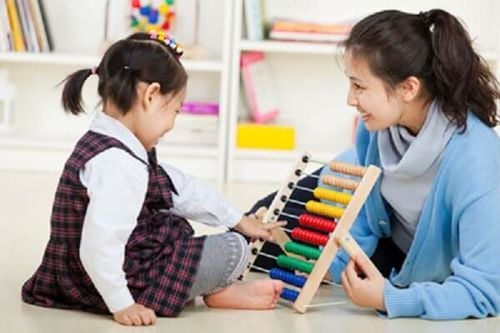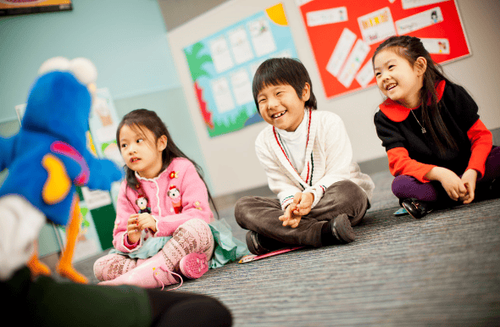This is an automatically translated article.
Article written by Medical Specialist Nguyen Thi Yen - Speech therapy - Department of Regenerative Medicine, Vinmec Times City International Hospital
A child's speech and language development depends on many factors, including the child's own and external factors.
1. How do children learn languages?
Each child is a "chart" with different developmental milestones in terms of physical, psychological, thinking, language,... In terms of language, some children can speak early, some children can talk. late ; some children learn only one language, some children learn many different languages at the same time; Some children learn to speak in communication sentences, while others have language and speech difficulties.
It is different, however, all children go through the same stages of speech and language development. Language acquisition for all children happens “naturally” and “gradually” through interactions with parents, siblings, and those around them.

Trẻ học ngôn ngữ thông qua khả năng lắng nghe
Factors can be mentioned such as:
Children's innate language learning ability: the ability to listen, perceive, process, imitate sounds, communicate motivation,... Other skills that Children learn How much conversation and communication do children hear each day How people react to what they say or do Thus, a child's learning to speak, in addition to his own internal strength, depends on depends a lot on the family and the people around the child who “create so many opportunities to encourage communication” each day.
You won't know for sure, your child will "speak" after 3 months, 6 months or after 1 school year. Each child's learning speed is different, some children learn fast, some children learn a little slower. That is very normal. Therefore, do not be too impatient, nor compare your baby with any other baby. If so, simply compare your child's progress today with that of yesterday.
2.So how do you teach your child language?

Hãy chơi cùng con để dạy ngôn ngữ cho con
Is your family living in the city or in the countryside? Are you in a family with many generations living together or a young family with young children? Does your family have a maid or help with the daily chores?... No matter where you are, how many people in your family, whether you have someone to help with housework or not, you are still “the most important person in your family.” " that the baby interacts and communicates every day. The way you play with your child, interact with him, and talk to him will determine his language development path, especially in the first years of life.
So to teach your child language, you should:
Play with your child How do you play with your child? Is it to buy a lot of toys and meet all their play needs or take advantage of everything in the house, according to their preferences, create games with them?
Many parents think that they must have toys to play with their children. However, the reality is the opposite, children like real objects and enjoy all the activities that happen every day with their parents. Therefore, let's turn all activities: from eating, bathing, walking, taking care of the garden, ... into real fun activities with your children every day. Toys or not, it doesn't matter that you are trying to be a "playmate" of your child and he understands that you care about his "play interests".

Đọc sách cùng con mỗi ngày
Be natural Being natural means showing your child that you are really happy and really enjoy spending time with them. All activities should be familiar, natural activities; Your feelings are natural and everything you say to your child is natural, not forced, not according to any "Pattern". Remember:
Talk spontaneously about what you and your child are doing or what your child is paying attention to. Listen and respond with words, gestures, and gestures to everything your child is trying to do. show off Read with your child every day Don't set any goals when you're with your child, you simply stay by your child's side, play with him and make it fun and enjoyable Maintain Language is Things are learned gradually, so try to keep playing and communicating with your child every day. For at least 30 minutes a day, schedule your child's playtime each day and try to spend time alone. Prepare everything: environment, activities, utensils, people so as not to interrupt your and your child's activities.
Know your child's important language milestones Language development milestones are extremely important for you to know if your child is on the threshold of "the vast majority" of children? What if my child doesn't meet typical developmental milestones? Pay more attention but don't worry too much.
Spend plenty of time playing, interacting and observing how your child learns from the world around them. Because each child's learning speed is different. If your child is still in the process of learning the language, help him learn it every day, don't try to push him to "hit the same developmental milestones as other children". This will be very young and stressful for you.

Con bạn có biểu hiện chậm phát triển về ngôn ngữ hãy kiểm tra khả năng hiểu ngôn ngữ của trẻ
Pay attention to the “red flags” The first three years are very important for your child's language learning. Pay attention to how your child communicates and interacts with others. Pay attention to whether your child can follow simple requests or answer your simple questions. If yes, show that your child is interested in communicating with you, listening, understanding and acting appropriately
For example, your child is 18-30 months old, but you notice that he does not speak as well as other children . Try more tests:
Children's ability to understand language. Try making requests like: “Give mom the remote for the TV”; “Where's your belly?”;... If understood well, after listening to the mother ask, the child will look around or stand up to look for control. Children are able to complete requests on their own without your prompting or support. In this case, you can trust your child's language abilities to soon catch up with other children. If, after you make the request, your child shows no interest or shows any signs that he has heard and is trying to find it, it is likely that your child has a language delay. Use gestures: Your child is able to use gestures quite flexibly, especially before he can speak well. Simple things like: fold your arms in greeting, wave goodbye, nod, shake your head, point to an object to show off. For children who use a lot of gestures and gestures to communicate, they will also catch up with other children of the same age fairly quickly. Ability to learn new words: You may speak late, but always try to learn every day. If your child tries or begins to put some words together, “where are you”, “go ball” then you can count on her ability to catch up with the language. If a child has difficulty in performing the above areas, this does not mean that the child has a language delay, but it does suggest that the child is more likely to have language difficulties than other children.
If your child's learning rate seems to be very slow. Spend more time with your child. I understand that some parents are extremely concerned that their child's speech and language development may appear to be slower than normal but are hesitant to seek professional advice from a speech and language therapist. Whether.
Sometimes they are reassured by family and friends that the child is too young to appreciate anything. In fact, it's never too early to assess your child's language skills. Take action early and provide timely support, especially during the first few years of your baby's life.
Please dial HOTLINE for more information or register for an appointment HERE. Download MyVinmec app to make appointments faster and to manage your bookings easily.
Articles refer to the source: asha.org













